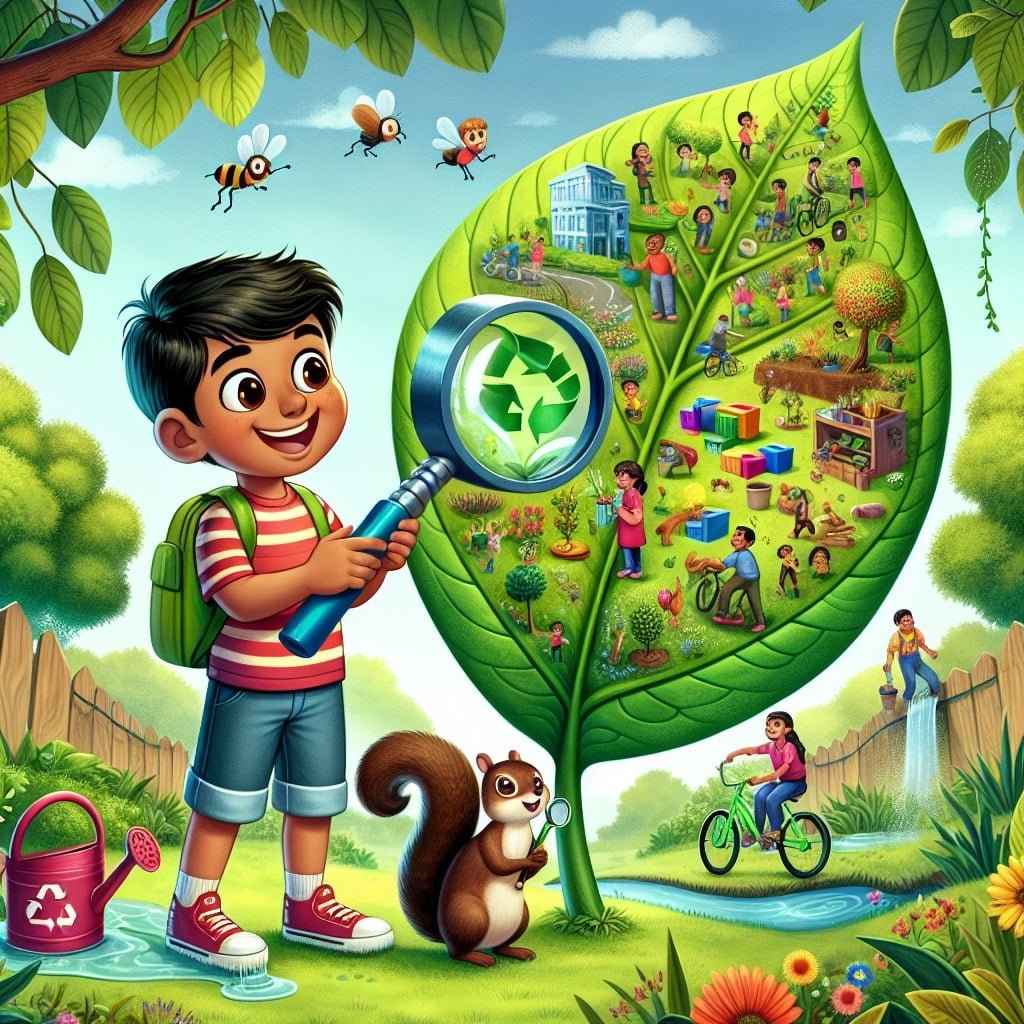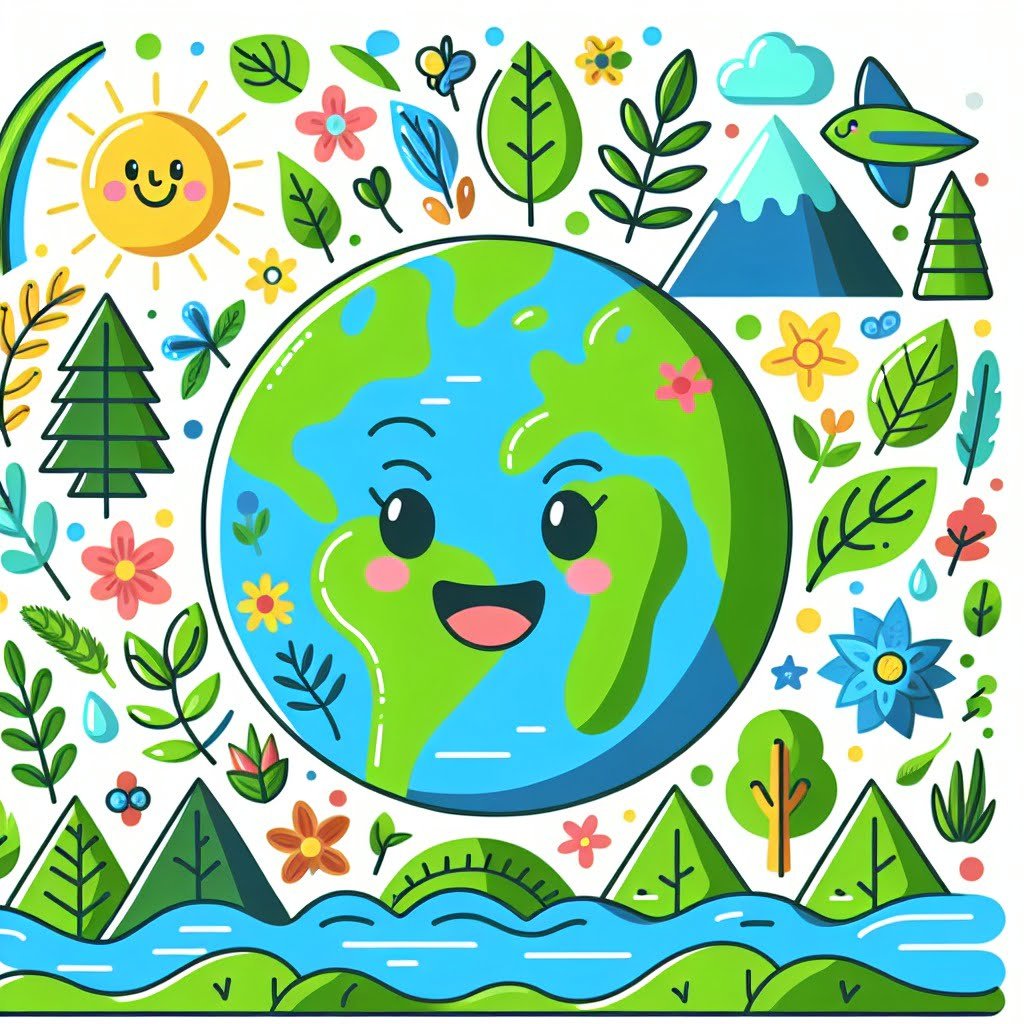Welcome to an exciting exploration of Nile River Facts For Kids! In this blog post, we delve into the wonders of the Nile River, uncovering fascinating information suitable for both younger and older audiences. From the impressive length of the Nile River to its unique northward flow, the abundance of wildlife in the Nile River Delta, and the historical significance of this majestic waterway, there is so much to discover. Join us as we uncover how the Nile River played a crucial role in ancient civilizations, provided a lifeline for trade and transportation, and continues to shape the landscape of Northeastern Africa today. Get ready to embark on a journey full of fun facts and captivating insights about the longest river in the world. Let’s dive in and explore the wonders of the Nile River together!
Nile River Facts For Kids
1. The Nile River is the Longest River in the World

For younger kids: The Nile River is the longest river on Earth!
For older kids: With a length of about 4,135 miles, the Nile River holds the title of the longest river globally, flowing through 11 countries in northeastern Africa.
Detailed explanation:The Nile River, stretching over 4,100 miles in length, is widely known as the longest river in the world. This famous river runs through northeastern Africa, flowing through multiple countries including Egypt, Sudan, Kenya, Tanzania, Rwanda, Burundi, Uganda, and Ethiopia. The Nile River is a vital source of life for the surrounding regions, providing water for agriculture, transportation, and electricity.
One of the key reasons why the Nile River is so crucial to the region is its annual flooding. Every year, the river overflows its banks, depositing nutrient-rich silt onto the surrounding lands. This natural irrigation process has enabled ancient civilizations like the Egyptians to thrive and prosper along its banks. The Nile River played a significant role in the development of one of the world’s earliest and most advanced civilizations, providing water for farming and facilitating trade and transportation.
For kids, learning about the Nile River can be both fascinating and educational. They can explore the rich history and culture associated with the river, including the construction of the pyramids of Giza and the temples of Luxor. Additionally, kids can study the diverse wildlife that inhabits the Nile River, such as crocodiles, hippos, and various species of fish and birds.
Overall, the Nile River Facts For Kids offer a captivating introduction to one of the most important and iconic rivers in the world. Its significance in history, geography, and ecology make it a fascinating subject to study for children and adults alike.
Nile River Facts For Kids
2. The Nile River Flows North
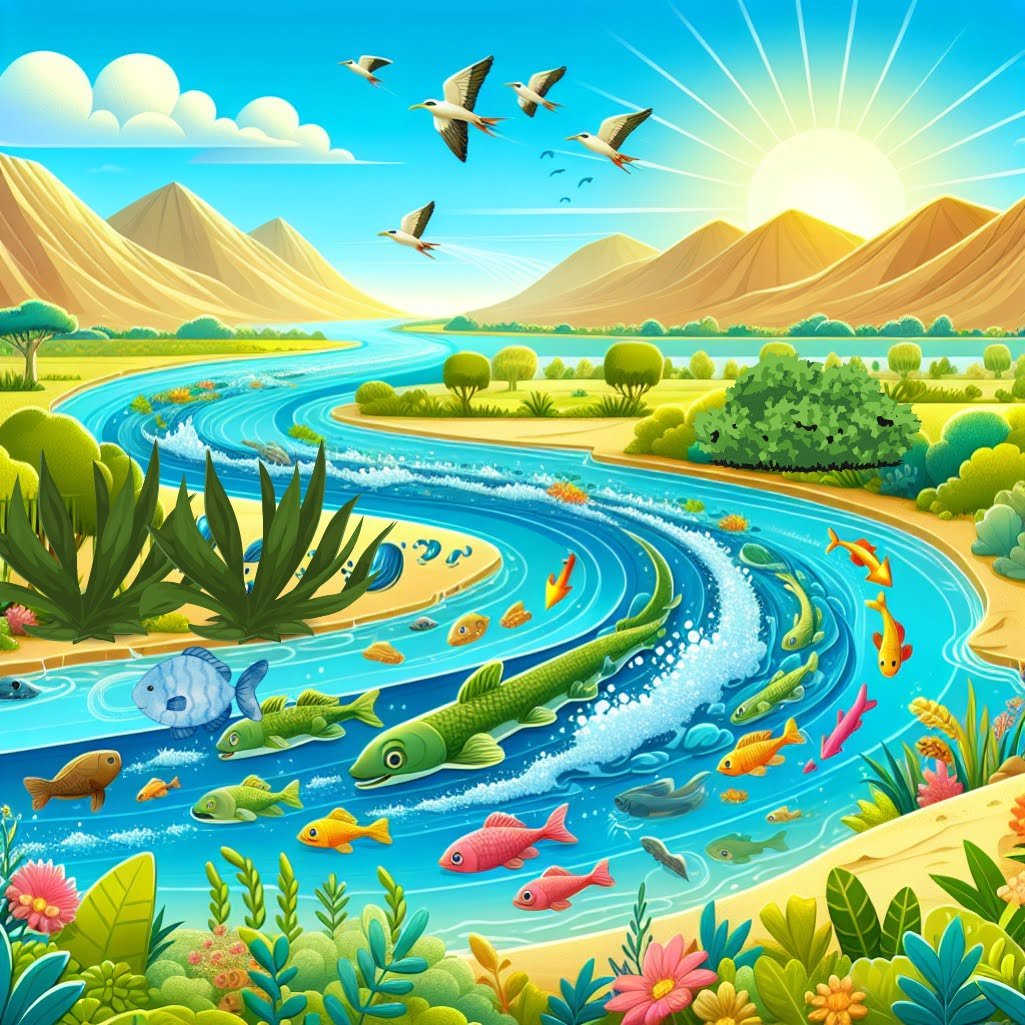
For younger kids: Most rivers flow south, but the Nile flows in the opposite direction!
For older kids: Unlike the majority of rivers that flow south, the Nile River stands out as it flows northwards, originating from the African Great Lakes region and emptying into the Mediterranean Sea.
Detailed explanation:One of the most fascinating Nile River facts for kids is that it flows northwards, unlike most other rivers in the world. The Nile River is unique in this aspect, as the majority of rivers flow from north to south or from west to east.
The reason behind the Nile River flowing north can be attributed to the geography of the region. The Nile River is fed by two main tributaries, the White Nile and the Blue Nile. The White Nile originates from Lake Victoria in Uganda, while the Blue Nile starts from Lake Tana in Ethiopia. These tributaries merge in Sudan before flowing northwards towards the Mediterranean Sea.
The Nile River’s northward flow is also influenced by the overall slope of the land in the region. The river flows downhill from higher elevations in the south towards lower elevations in the north, leading to its unique direction. Additionally, the ancient tectonic activity in the region played a role in shaping the Nile River’s course.
The northward flow of the Nile River has had significant historical and cultural implications for the people living along its banks. The river has been a crucial source of water, food, and transportation for civilizations that have thrived in Egypt and other Nile-dependent regions.
In conclusion, the fact that the Nile River flows north is a remarkable natural phenomenon that sets it apart from other rivers around the world. Its unique direction has shaped the history and livelihoods of those who depend on it, making it a truly special feature of the natural world.
Nile River Facts For Kids
3. The Nile River is Home to the Nile Crocodile
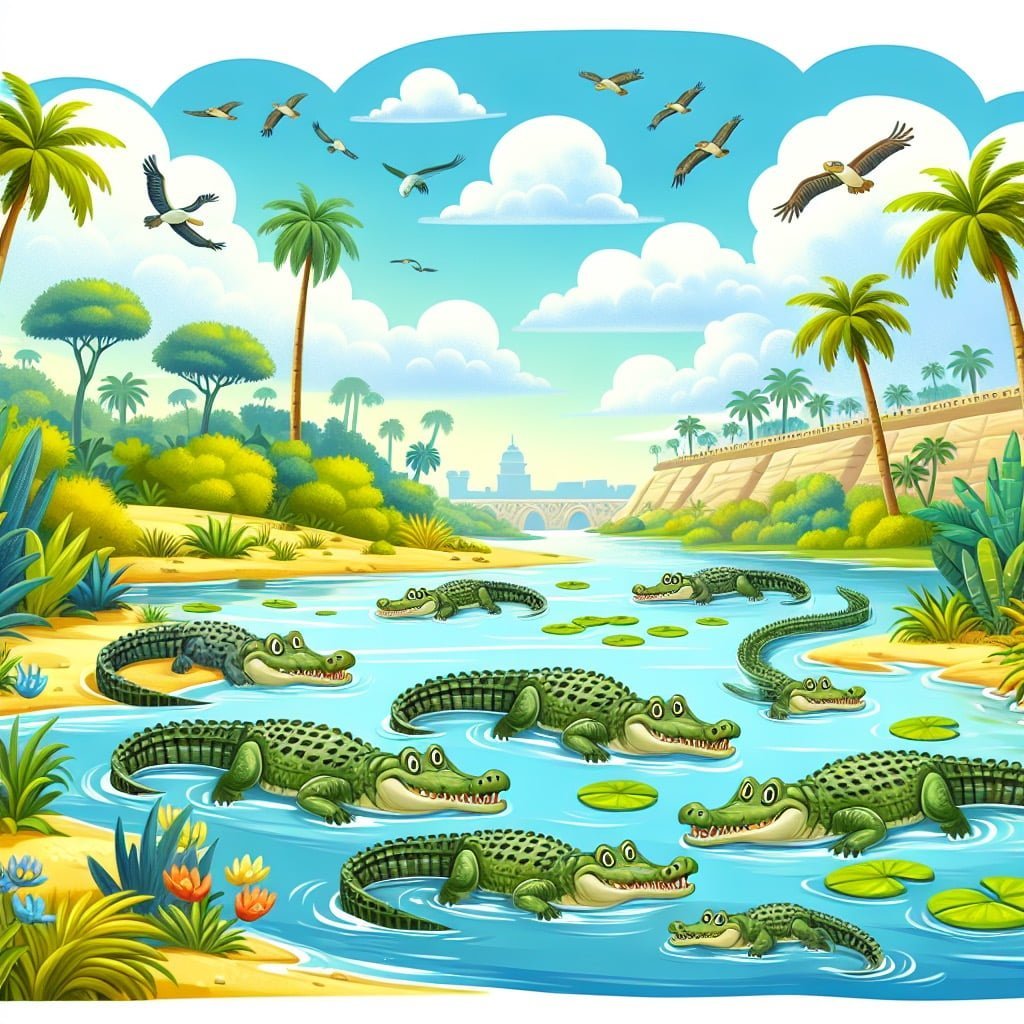
For younger kids: The Nile River has crocodiles that swim in its waters!
For older kids: The Nile River is inhabited by the Nile crocodile, a fearsome reptile known for its aggressive nature and ability to grow up to 20 feet in length.
Detailed explanation:The Nile River, one of the longest rivers in the world, is not only known for its historical significance and the civilizations that flourished along its banks, but also as a habitat for diverse wildlife. Among the fascinating creatures that call the Nile River home, the Nile Crocodile stands out as a powerful predator that has adapted to thrive in this unique ecosystem.
For kids learning about the Nile River, the presence of the Nile Crocodile adds an element of excitement and danger to their understanding of this mighty waterway. These ancient reptiles can grow up to 16 feet in length and are known for their stealthy hunting techniques. With sharp teeth and powerful jaws, they are capable hunters, preying on fish, birds, and even larger mammals that come to drink from the river.
For kids interested in wildlife and biology, studying the Nile Crocodile can provide insights into the importance of apex predators in an ecosystem. As top predators, Nile Crocodiles play a crucial role in regulating the population of other species, helping maintain a balance in the delicate web of life along the Nile River.
Learning about the Nile Crocodile also offers kids a chance to appreciate the wonders of evolution and adaptation. These reptiles have survived for millions of years, thanks to their remarkable abilities to camouflage, swim swiftly, and ambush their prey. Understanding these adaptations can inspire curiosity and awe in young minds, sparking an interest in the natural world and the complex relationships between different species.
In conclusion, the Nile River is not just a historical and geographical wonder, but also a thriving ecosystem that supports a wide array of fascinating creatures, including the impressive Nile Crocodile. By learning about these creatures, kids can deepen their appreciation for the natural world and the interconnectedness of all life forms.
Nile River Facts For Kids
4. Ancient Egyptians Relied on the Nile for Survival

For younger kids: The Nile River was essential for the Ancient Egyptians to live and grow crops!
For older kids: In Ancient Egypt, the Nile River played a crucial role in providing water, fertile soil for agriculture, transportation, and sustenance for the people through fishing.
Detailed explanation:The Nile River, the longest river in the world, played a crucial role in the survival of the ancient Egyptians. The civilization that thrived along the banks of the Nile was heavily dependent on the river for a variety of reasons. Firstly, the Nile provided water for drinking, bathing, and irrigating crops. The annual flooding of the river deposited nutrient-rich silt onto the banks, making the land fertile and ideal for agriculture. This allowed the ancient Egyptians to grow a variety of crops such as wheat, barley, and flax.
Furthermore, the Nile River served as a transportation route for the ancient Egyptians. They used boats made from papyrus reeds to travel up and down the river, facilitating trade and communication between different regions. The river also provided a food source in the form of fish, which the ancient Egyptians caught using nets and traps.
In addition to these practical uses, the Nile River held great religious and cultural significance for the ancient Egyptians. They believed that the river was a gift from the gods and that it was the source of all life. The annual flooding of the Nile was seen as a symbol of rebirth and renewal, and the Egyptians celebrated this event with festivals and ceremonies.
In conclusion, the Nile River was truly the lifeblood of ancient Egyptian civilization. Its importance in providing water, food, transportation, and spiritual sustenance cannot be overstated. The ancient Egyptians revered the Nile as a vital and sacred element of their existence, highlighting the profound impact that this great river had on their society.
Nile River Facts For Kids
5. The Nile River Delta is a Biodiversity Hotspot
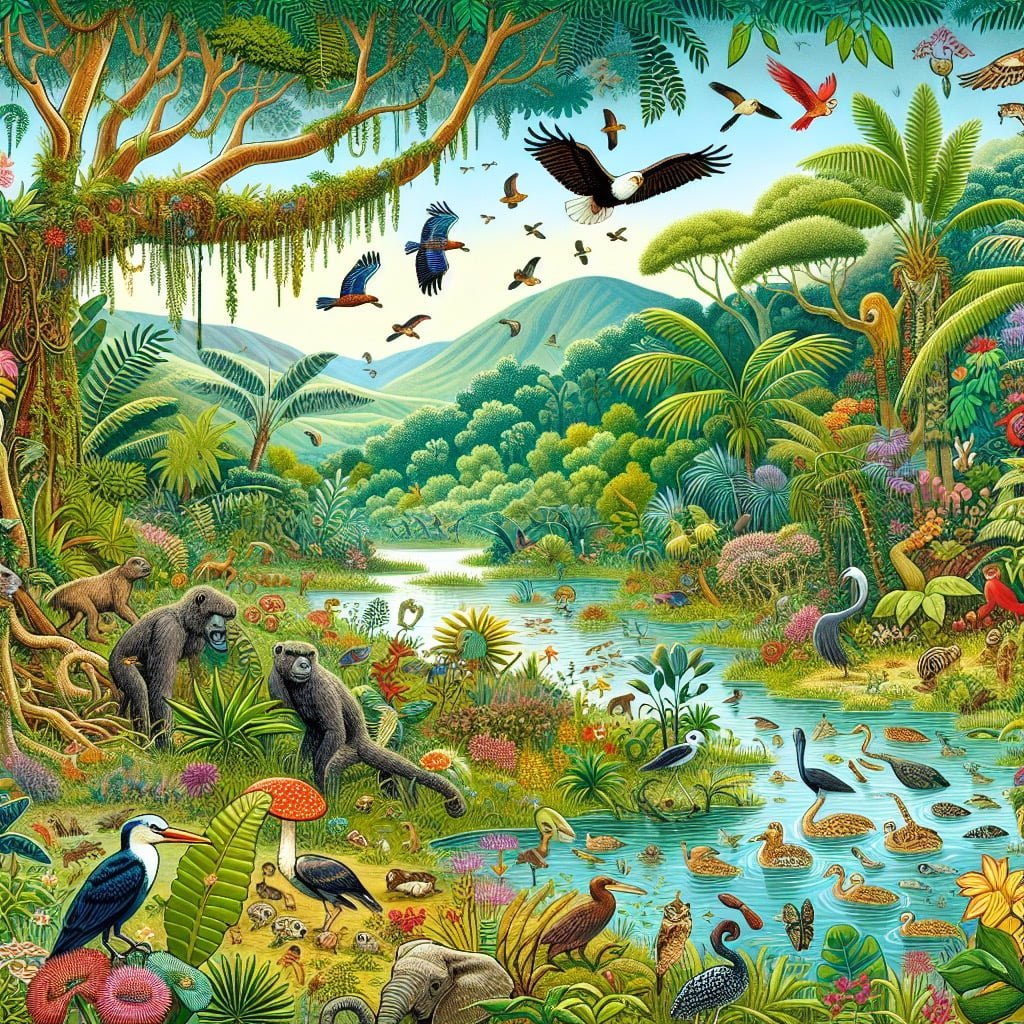
For younger kids: The Nile River Delta is full of amazing plants and animals!
For older kids: The Nile River Delta, where the Nile meets the Mediterranean Sea, is a biodiversity hotspot teeming with unique species of flora and fauna thriving in the lush wetlands.
Detailed explanation:The Nile River Delta is a Biodiversity Hotspot, meaning that it is an area with an incredibly high level of biodiversity, or a wide variety of plant and animal species. The delta of the Nile River, where it empties into the Mediterranean Sea, is home to a diverse array of habitats including wetlands, marshes, and coastal dunes. This unique combination of ecosystems provides a rich and varied environment for a wide range of flora and fauna to thrive.
One of the reasons why the Nile River Delta is such a biodiversity hotspot is its location at the crossroads of different ecosystems. The river brings nutrient-rich water from central Africa, creating fertile conditions that support a diverse range of plant life. This abundance of vegetation in turn provides food and shelter for a variety of animal species, including birds, fish, and mammals.
The delta is also an important stopover point for migratory birds traveling between Europe and Africa. These birds rely on the delta’s rich food sources to refuel during their long journeys, making it a crucial resting place for many different species.
In addition, the Nile River Delta is home to several endangered species, including the slender-billed curlew and the Mediterranean monk seal. Conservation efforts are underway to protect these vulnerable animals and their habitats, highlighting the importance of preserving the biodiversity of this unique ecosystem.
Overall, the Nile River Delta’s status as a biodiversity hotspot is a testament to the rich and varied natural world that can be found along the banks of this iconic river. By recognizing and protecting the diverse array of species that call this region home, we can ensure that future generations of children will continue to be fascinated by the wonders of the Nile River ecosystem.
Nile River Facts For Kids
6. The Blue Nile and White Nile Merge in Sudan
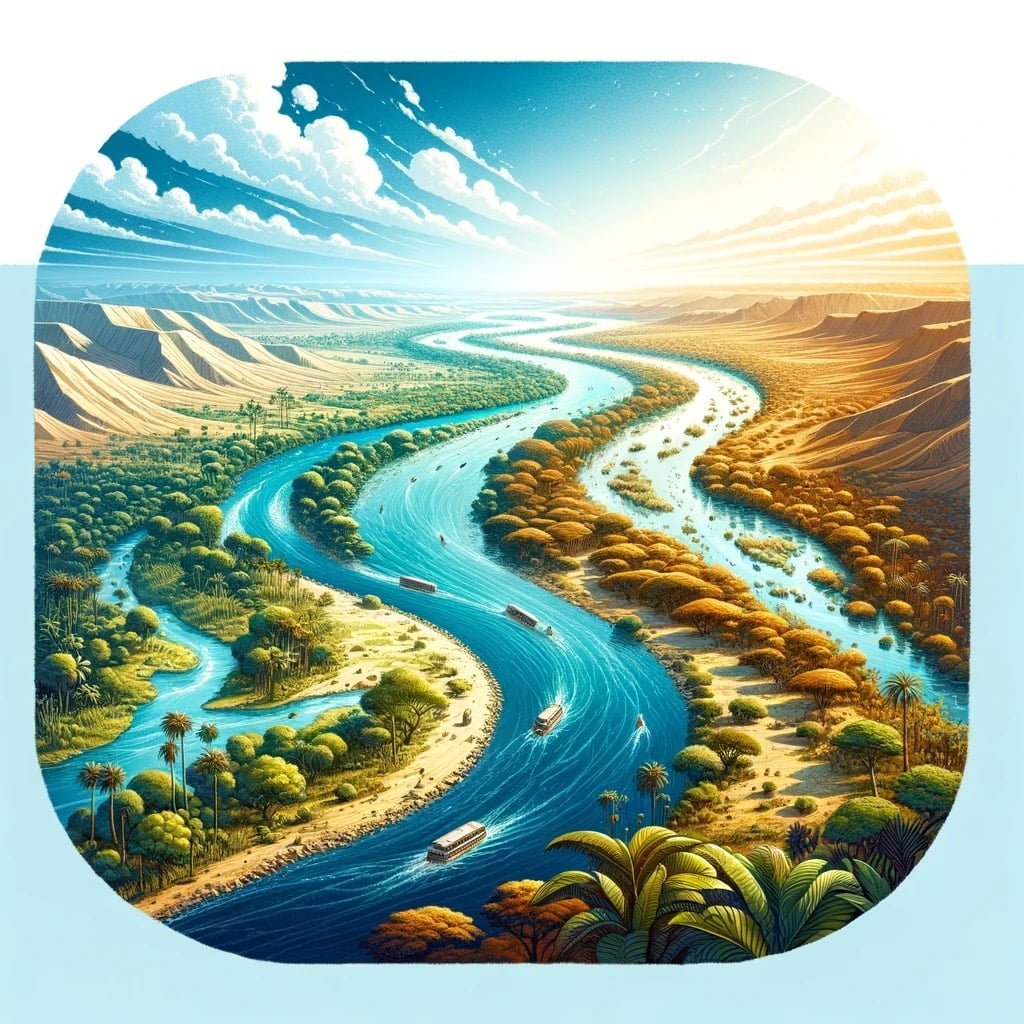
For younger kids: Two rivers meet to create the big Nile River we know!
For older kids: In Sudan, the Blue Nile and White Nile rivers converge, joining forces to form the iconic Nile River that flows northwards through Egypt.
Detailed explanation:The merging of the Blue Nile and White Nile in Sudan is a significant geographical event along the course of the Nile River. This merge takes place near the capital city of Khartoum, where the Blue Nile, which originates from Lake Tana in Ethiopia, and the White Nile, which begins at Lake Victoria in Uganda, meet and become one river flowing north towards Egypt.
The Blue Nile gets its name from the sediment-rich water that gives it a bluish tint, while the White Nile is named for the whitish-grey clay particles suspended in its waters. The meeting point of these two tributaries marks the beginning of the main Nile River, which eventually flows through various countries in East Africa before reaching the Mediterranean Sea.
This confluence is not only a physical merging of waters but also a blending of different characteristics. The Blue Nile is known for its fast-flowing, turbulent waters, especially during the rainy season, while the White Nile has a steadier flow due to its origins in the large Lake Victoria. As they come together, their unique qualities combine to form a single, powerful river that sustains life for millions of people along its banks.
For kids learning about the Nile River, understanding the merging of the Blue and White Niles is crucial in grasping the complex nature of this iconic waterway. It showcases the dynamic forces of nature and how different rivers can come together to create something even greater. Witnessing this convergence is not only a remarkable sight but also a reminder of the interconnectedness of Earth’s natural systems.
Nile River Facts For Kids
7. The Nile River Has Historical Importance in Religion
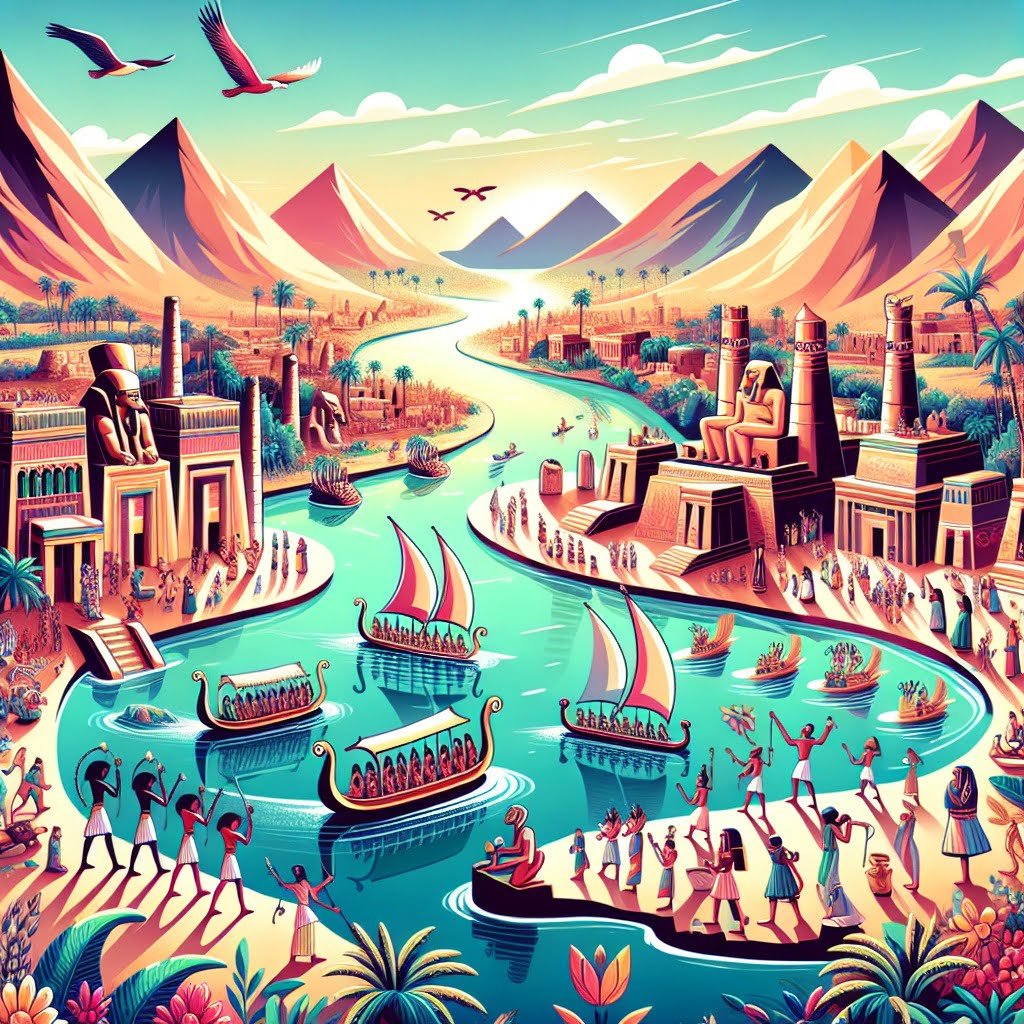
For younger kids: The Nile River is important in stories of ancient gods and goddesses!
For older kids: In various ancient Egyptian religious beliefs, the Nile River held immense significance and was often associated with deities like Hapi, the god of the annual flooding that brought fertility to the land.
Detailed explanation:The Nile River, stretching through multiple countries in Africa, holds significant historical importance in religion. For thousands of years, various civilizations along the banks of the Nile have revered the river as sacred and linked it to their religious beliefs. In ancient Egyptian mythology, the Nile River was considered the lifeblood of the land, with its annual flooding bringing fertility to the surrounding soil and ensuring abundant harvests. The river was personified by the goddess Hapi, who was worshipped for bringing prosperity and abundance to the people.
Moreover, the Nile River played a crucial role in the religious practices of other ancient civilizations as well. The river was vital to the development of early Christianity, as it is believed to be the location where Moses was discovered among the reeds and where he later parted the waters to lead the Israelites to safety. The Nile also features prominently in Islamic history, with Egypt being home to many important mosques and religious sites along the riverbanks.
In modern times, the Nile River continues to hold religious significance for many people living in the region. Pilgrimages to the river are still undertaken by some groups, and offerings are made to honor the ancient deities associated with its waters. The Nile River’s historical importance in religion has left a lasting impact on the cultural traditions and beliefs of those who dwell along its banks, making it not just a vital source of water and sustenance, but also a spiritual center for countless generations.
Nile River Facts For Kids
8. The Nile River Valley is an Archaeological Treasure Trove

For younger kids: The Nile River Valley has secret treasures waiting to be discovered!
For older kids: The Nile River Valley is renowned for its archaeological sites, including the Valley of the Kings, where ancient tombs and artifacts have been unearthed, shedding light on Egypt’s rich history.
Detailed explanation:The Nile River Valley truly is an archaeological treasure trove, with a rich history that dates back thousands of years. This ancient civilization is known for its impressive structures, hieroglyphics, and artifacts that have provided valuable insights into the way people lived along the Nile River.
One of the most famous archaeological sites along the Nile River is the ancient city of Thebes, located in modern-day Luxor, Egypt. The Valley of the Kings and the Valley of the Queens are also located nearby, where numerous tombs of pharaohs and nobles have been discovered. These tombs are adorned with intricate hieroglyphics and beautiful artwork, shedding light on the religious beliefs and daily life of ancient Egyptians.
Another significant archaeological site along the Nile River is the city of Memphis, which was once the capital of ancient Egypt. The ruins of temples, palaces, and statues found in Memphis provide a glimpse into the grandeur of this ancient city.
Excavations along the Nile River have also uncovered countless artifacts, such as pottery, tools, and jewelry, which offer valuable insights into the daily lives of ancient Egyptians. These discoveries have helped archaeologists piece together the puzzle of Egypt’s past and understand the development of one of the world’s oldest civilizations.
In conclusion, the Nile River Valley is a treasure trove of archaeological wonders, offering a window into the past for both researchers and visitors alike. The rich history and wealth of artifacts found along the Nile River continue to fascinate and inspire people of all ages today. Kids, in particular, can learn a great deal about ancient Egypt and its culture by exploring the archaeological sites along the Nile River.
Nile River Facts For Kids
9. The Nile River was a Lifeline for Trade and Transport
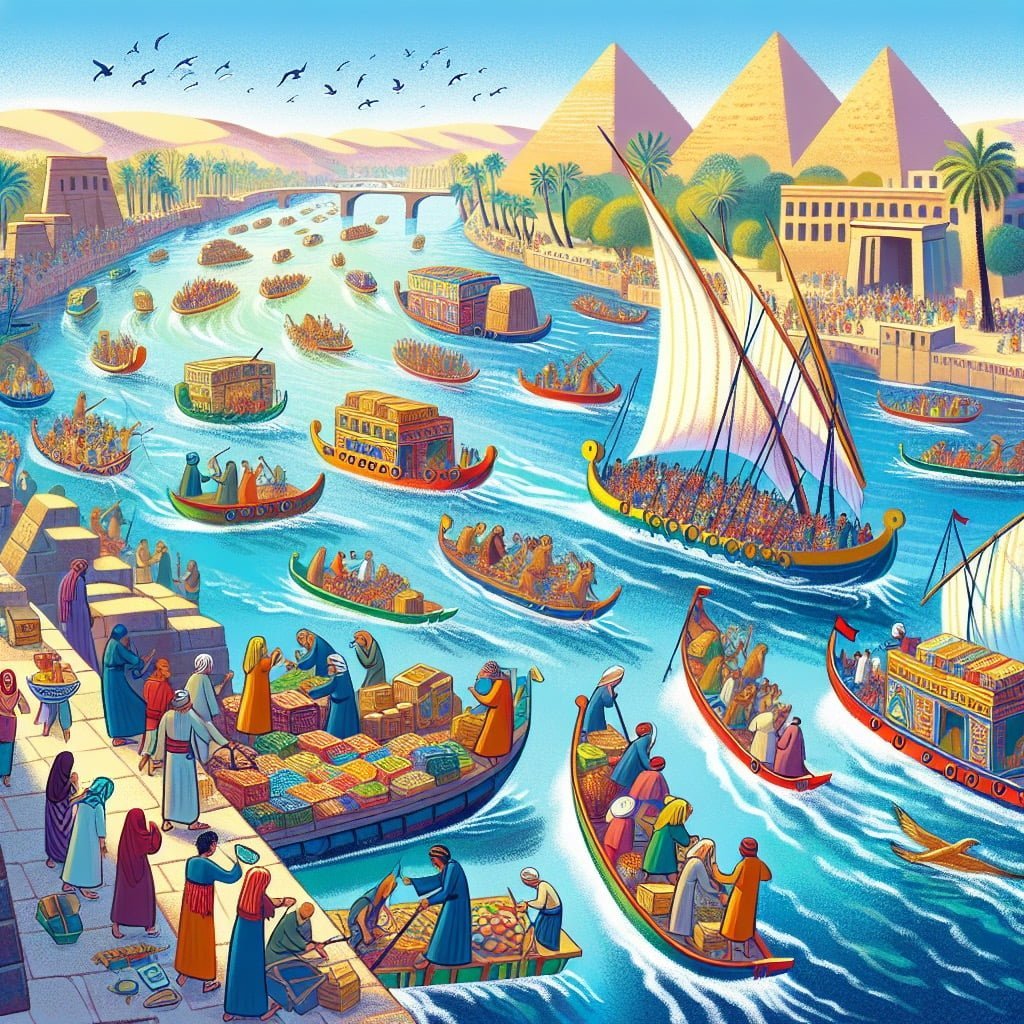
For younger kids: People used the Nile River to travel and trade goods a long time ago!
For older kids: In ancient times, the Nile River was a vital route for trade and transportation, facilitating the movement of goods, people, and ideas between different regions along its banks.
Detailed explanation:The Nile River, a majestic waterway flowing through the heart of Africa, has played a crucial role in the development of early civilizations and cultures. One fascinating aspect of the Nile River is its importance as a lifeline for trade and transport.
For thousands of years, the Nile River has served as a vital artery connecting different regions and people. The ancient Egyptians, for example, utilized the Nile for transporting goods such as grains, minerals, and other resources. The river provided them with easy access to trade routes that extended across North Africa and the Mediterranean region.
Furthermore, the Nile River facilitated the movement of people and goods within Egypt itself. Farmers living along the banks of the river used it to transport their crops to markets in nearby towns and cities. The river also allowed for the effective transportation of building materials, such as stones for the construction of magnificent temples and pyramids.
Moreover, the Nile River was not only a means of trade and transport but also a source of sustenance and livelihood for the people living in its vicinity. The river’s annual floods deposited nutrient-rich silt on the surrounding land, making it fertile for agriculture. This allowed the ancient Egyptians to cultivate crops such as wheat, barley, and flax, ensuring food security for the population.
In conclusion, the Nile River’s role as a lifeline for trade and transport was essential in shaping the economies and societies of ancient civilizations. Its importance cannot be overstated, as it not only connected regions and facilitated commerce but also provided vital resources for the people living along its banks.
Nile River Facts For Kids
10. The Nile River’s Flow is Regulated by the Aswan High Dam

For younger kids: An important dam was built to control the Nile River’s water levels!
For older kids: The Aswan High Dam, constructed in Egypt, helps regulate the flow of the Nile River, ensuring a steady water supply for irrigation, electricity generation, and flood control in the region.
Detailed explanation:The Nile River, one of the longest rivers in the world, stretches over 4,000 miles through northeastern Africa. It flows through multiple countries, including Egypt, Sudan, Ethiopia, Kenya, Uganda, Rwanda, Burundi, and the Democratic Republic of the Congo. One important fact about the Nile River that is crucial to understand is that its flow is regulated by the Aswan High Dam.
The Aswan High Dam, located in Egypt, was completed in 1970 and plays a vital role in controlling the flow of the Nile River. Before the dam was built, the Nile would flood unpredictably every year, causing damage to crops, homes, and infrastructure in the surrounding areas. The dam has helped to regulate the river’s flow, preventing destructive floods and providing a reliable source of water for irrigation, drinking, and electricity generation.
In addition to regulating the flow of the Nile River, the Aswan High Dam has also created Lake Nasser, one of the largest artificial lakes in the world. This reservoir helps to store water during times of high flow, releasing it gradually during dry periods to ensure a consistent water supply downstream.
Overall, the Aswan High Dam has had a significant impact on the management of the Nile River, providing much-needed stability and control over its flow. This is an important concept for kids to grasp when learning about the Nile River, as it showcases how humans can effectively manage natural resources to meet various needs.
Did you know?
Did you know that the Nile River is so long that it could wrap around the Earth almost 1.5 times?
Summary of Nile River Facts For Kids
Do you know that the Nile River is the longest river in the world, spanning 4,135 miles and flowing through 11 different countries in northeastern Africa? In this blog post, we uncover fascinating facts about the Nile River that are sure to captivate the minds of both younger and older kids. From the unique phenomenon of the Nile River flowing northwards to its importance in ancient Egyptian civilization, the Nile River holds a wealth of wonders waiting to be explored. Discover why the Nile River is not only a lifeline for trade, transportation, and agriculture but also a hotspot for biodiversity and archaeological discoveries. Dive into the captivating world of the Nile River and unlock its secrets that have shaped history and culture for thousands of years.
Sources and additional information for Nile River Facts For Kids
WikipediaBritannicaEnvironmental Protection Agency (EPA)National Oceanic and Atmospheric Administration (NOAA)The Nature ConservancyWorld Wildlife FundEarth Day NetworkGreenpeace InternationalJane Goodall InstituteEnvironmental Protection Agency (EPA)World Wildlife Fund – ConservationNature ConservancyGreenpeaceUnited Nations Environment Programme (UNEP)Conservation InternationalEarthwatch InstituteEnvironmental Defense FundSierra Club


